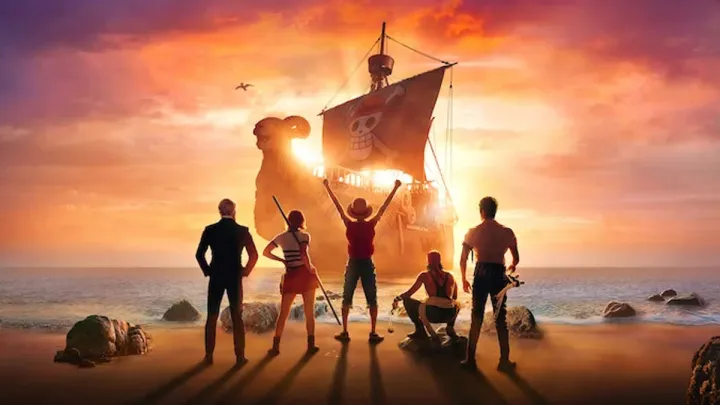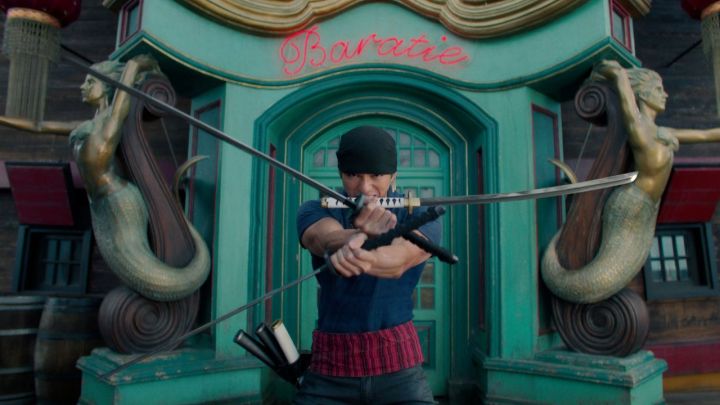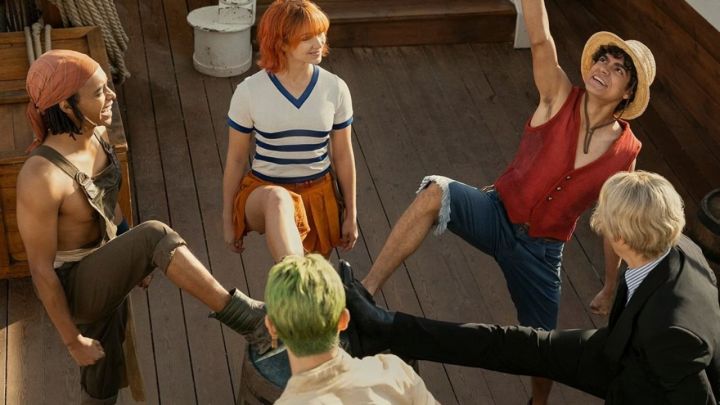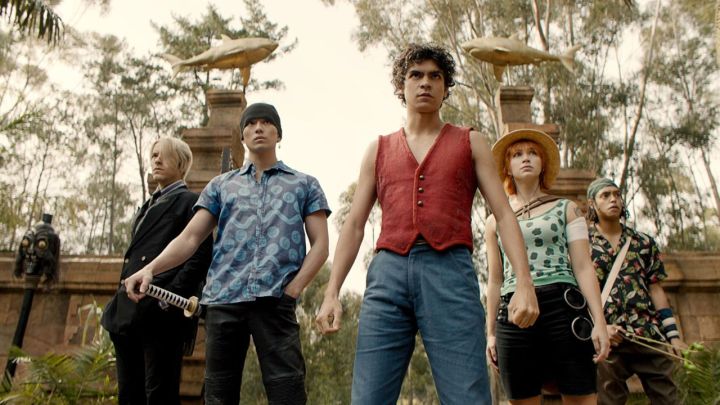
Netflix’s long-awaited adaptation of Eiichiro Oda’s beloved manga-turned-anime One Piece is finally here, and against all expectations, it’s a surefire hit. Critics reacted enthusiastically to the show, acknowledging its flaws but praising its many strengths. Equally important was the audience reception, which has been positive enough for the show to debut near the top of Netflix’s 10 most popular movies of the week. And considering we live in one of the most divisive times for major IPs, the strong audience reaction to One Piece is quite impressive.
Adapting an anime as silly and self-aware as One Piece was always going to be a daunting and potentially thankless task. Stay too close to the source material and risk accusations of not being polished enough for live-action; veer too far away and provoke the wrath of millions of loyal fans. The show would also have to endure constant variations of the “who is this for?” argument reviewers and viewers throw at the constant live-action adaptations studios and streamers churn out every year. Yet, One Piece did so valiantly, daring to tread its own path and earning praise from both sides of the argument.
Still, one question looms large over the show, and it’s becoming increasingly apparent with the benefit of hindsight. Is One Piece too faithful to its source material? A better question yet is, can something be too faithful? After all, isn’t the purpose of an adaptation to alter these properties and make them better suited for a new medium? But can we do that in today’s climate, where every change is considered a slight against the previously existing fandom? Can an adaptation truly live up to its name?
A visual mixed bag

Let’s get something straight: One Piece is a good and occasionally great show. It stumbles in the middle but follows the cardinal rule of storytelling: start and end with a bang to leave audiences wanting more. Most impressively, it’s a satisfying watch even for new fans who have never experienced Oda’s manga or anime. Perhaps that is One Piece‘s greatest strength: it condenses nearly 100 episodes of the long-running anime into 8 hours of live-action without losing sight of what’s important.
Considering this, One Piece can’t be too faithful; how can it, when it modifies and outright cuts numerous side stories to focus on the larger picture? However, none of these changes are major enough to cause fans to complain about cut characters or storylines. But the show often falls victim to what brings down many great adaptations by rehashing, rather than reinterpreting, the source material. Many shots are close to being direct copies of the manga and anime, lacking the visual punch one might expect from an $18 million-an-episode tentpole. Zoro’s pivotal fight against Dracule Mihawk is a near-perfect replica of the anime, and while there is a certain magic in seeing such a classic fight in live-action, Netflix’s version provides nothing the original anime didn’t.
Few, if any, fans are in this expecting a one-to-one reproduction of what they already saw. But this is a flaw inherent to any live-action project; unlike a book, where the reader’s mind does all the heavy lifting, an anime already offers enough visual thrills to make any new version feel redundant. For a live-action to succeed, it must adapt to its new medium, which usually means upping the visuals.
In this aspect, One Piece succeeds with flying colors. The show has a distinctive visual language, largely thanks to its inspired mix of CGI and physical sets. The scenery is lush and vibrant, echoing the anime’s style without looking like a cheap copy. Luffy’s famous Devil Fruit powers also successfully transition to live-action; they look silly and cartoonish, but that’s the point.
Visually, One Piece is a mixed bag. It’s too enamored with its source material to venture on its own, but it triumphantly creates a distinctive and almost cinematic visual language that perfectly enhances its admittedly safe approach. Would One Piece be better had it dared to experiment more with its visuals? It’s hard to say; more people would be angry, that’s for sure. But it might’ve stood out among the sea of weekly competitors, perhaps measuring up against HBO’s brand of prestige television rather than sitting atop Netflix’s long line of run-of-the-mill content.
It’s all about the essence

When adapting something, most fans will say the important thing is to maintain the “essence.” Just what exactly is this essence, though? It varies from project to project and has a different meaning for each fan. For something like One Piece, it’s a sense of charm and unabashed positivity that make the anime and its timeless protagonist, Monkey D. Luffy, such massive icons. And Netflix’s live-action has it in spades. Iñaki Godoy is an instant star as the show’s lead, wisely choosing to embody Luffy’s overwhelming and spirited personality rather than merely acting it. The rest of the cast does brilliantly, too, and One Piece can proudly say there are no weak links among its ranks.
Thus, One Piece avoids the tragic fate that brought down many other unsuccessful adaptations. Netflix’s own Cowboy Bebop notoriously failed to recapture its source material’s cool and elusive blend of noir and Western. Its much-discussed, usually lampooned, and increasingly struggling adaptation of The Witcher nails the characters but struggles everywhere else and lacks a coherent visual language. And let’s not even go into its derided attempt to bring Death Note into live action.
Recapturing something’s “essence” is far more difficult than imagined. One Piece‘s reverence for the source material pays off in this crucial department by understanding what makes it work and effectively translating it into a new medium. Series masterminds Steven Maeda and Matt Owens transfer the anime’s gloriously over-the-top style without compromising its nature; One Piece is as grand as a live-action project can be before descending into ridicule. It admirably walks the fine line between absurdism and genius, dipping one foot on each side without committing to one. It’s a delicate balance that becomes increasingly apparent as the episodes progress and the source material’s more quaint aspects begin to shine.
Between fishmen and disjointed clowns, One Piece can easily succumb to its farcical devices. By remaining self-aware and unashamed of itself, the show emerges victorious where so many others caved. One Piece is in on the joke; you laugh alongside it but never at it.
Damned if you do, damned if you don’t

Adapting any beloved IP is always a losing game, especially with the divided entertainment landscape we live in today. Releasing anything is a leap of faith, and while it’s easy to disqualify something for being disappointing or outright bad, it’s harder to appreciate the nuances that come with translating something into live action. One Piece is not perfect and probably could never be; embracing its source material ensured it. However, the show made an empowered choice to exist within its self-imposed confinements, for better and worse. It succeeds as an adaptation but limits itself to forever exist as an underling, rather than a peer, of Oda’s creations.
Think of the most successful live-action adaptations – Harry Potter, The Hunger Games, The Lord of the Rings, Game of Thrones. These franchises exist on their own, standing side by side with the source material that inspired them rather than serving as a mere complement. In fact, they now have exclusive and enduring legacies. How many Game of Thrones fans lived for the show without ever reading a word George R. R. Martin wrote?
One Piece will never have that. It will forever exist as a supplement to the manga and the anime, and that’s okay. Not every IP can stand independently from its source material, mainly because not every IP should. Netflix’s One Piece is good for what it is; sure, it could’ve been great, but perhaps greatness is too much to ask from such a delightful show, especially considering the thrill of independence didn’t exactly last for most other franchises who carved paths away from their source materials.
Is One Piece too faithful? Yes, to its ultimate detriment. Was there room for change that would’ve resulted in a bolder, more rewarding adaptation? Yes. In other words, One Piece could’ve been another The Last of Us; the key aspect here is it chose not to be, which is perfectly valid. Not everything can be great; not everything has to be. Sometimes, “good” is enough. Embracing the “good” might be the way to enjoy things again. God knows we need to.
You can stream all eight episodes of One Piece right now on Netflix.
Editors' Recommendations
- Forget Loki; Invincible is the best superhero show you’re not watching right now
- 7 underrated Netflix shows you should be watching
- The 10 best characters on The Boys, ranked
- Is Netflix the right home for The Sandman?
- Enter the world of The Sandman in Netflix’s new trailer




